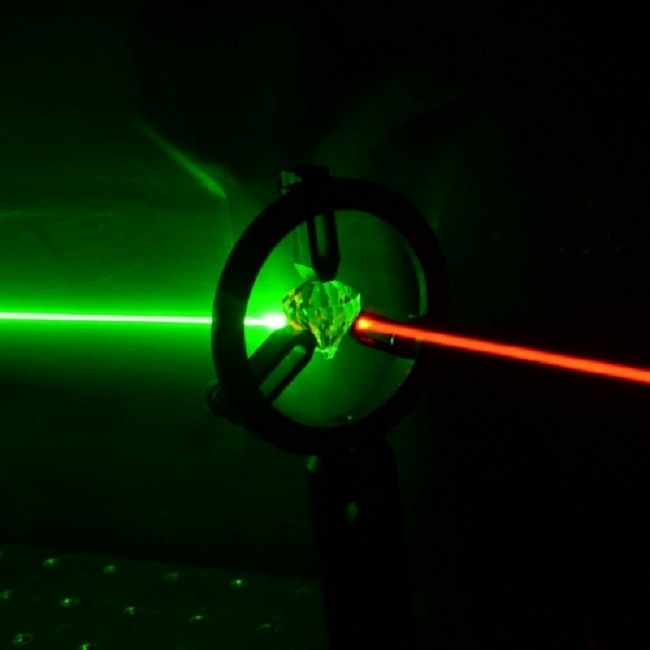Apr 6 2016
A team of researchers from the National Research Council of Canada (NRC) and the Institute for Quantum Computing at the University of Waterloo have used a room-temperature diamond quantum memory to transform the bandwidth and color of super-fast single photons.
 An artist’s impression of quantum frequency conversion in a diamond quantum memory. (Credit: Dr. Khabat Heshami, National Research Council Canada)
An artist’s impression of quantum frequency conversion in a diamond quantum memory. (Credit: Dr. Khabat Heshami, National Research Council Canada)
Changing the frequency of photon, or shifting its color, is important to optimally link components present in a quantum network. For instance in optical quantum communication, the perfect transmission across an optical fiber is near infrared, but a number of sensors that measure them are capable of working in a better manner for visible light because it is a higher frequency. Higher performance operation and bigger data rates are obtained when the photon’s color is shifted between the sensor and the fiber.
The study, featured in Nature Communications, illustrates how small frequency shifts are suitable for a communication protocol referred to as wavelength division multiplexing. Currently, this communication protocol is used when huge volumes of data need to be sent through a transmission, in order to break the signal into tiny packets of varied frequencies that are then sent together. The received information is then systematically ordered at the other end in accordance with those frequencies.
The researchers have carried out a number of experiments to illustrate the transformation of both the bandwidth and frequency of single photons, using room-temperature diamond quantum memory.
Originally there was this thought that you just stop the photon, store it for a little while and get it back out. The fact that we can manipulate it at the same time is exciting. These findings could open the door for other uses of quantum memory as well.
Kent Fisher, PhD student, Institute for Quantum Computing, University of Waterloo
The diamond quantum memory changes the photon into a specific vibration of the carbon atoms present in the diamond, known as a phonon. This transformation works for a wide range of colors of light, thus permitting the manipulation of a broad light spectrum. The diamond’s energy structure allows this to take place under extremely low noise at room temperature. Powerful laser pulses were used to store and then retrieve the photon. The researchers monitored the colors of these laser pulses, and as a result they were also able to control the color of the retrieved photon.
The fragility of quantum systems means that you are always working against the clock. The interesting step that we’ve shown here is that by using extremely short pulses of light, we are able to beat the clock and maintain quantum performance.
Duncan England, Researcher, NRC
The integrated platform for spectral conversion and photon storage is capable of being used for frequency multiplexing in quantum communication. The platform can also be used develop a cluster state, which is an extremely big entangled state. Researchers are keen to use cluster states as the resource for quantum computing is driven totally by measurements.
Canada is a power-house in quantum research and technology. This work is another example of what partners across the country can achieve when leveraging their joint expertise to build next-generation technologies.
Ben Sussman, Program Leader, NRC’s Quantum Photonics Program